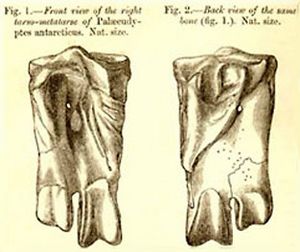Palaeeudyptes antarcticus facts for kids
Quick facts for kids Palaeeudyptes antarcticus |
|
|---|---|
 |
|
| Huxley’s original drawing of a fossil ankle bone from Palaeeudyptes antarcticus, described in 1859. | |
| Scientific classification | |
| Genus: |
Palaeeudyptes
|
| Species: |
antarcticus
|
| Synonyms | |
|
Palaeeudyptes antarctica (lapsus) Lowe, 1933 |
|
Palaeeudyptes antarcticus, also known as the narrow-flippered penguin, was a giant extinct penguin. It is the main example for the group of penguins called Palaeeudyptes. These birds were huge, though their exact size could vary.
Scientists believe these penguins stood between 43 and 55 inches (about 1.1 to 1.4 meters) tall. This makes them even bigger than today's emperor penguins! Palaeeudyptes antarcticus and its close relative, Palaeeudyptes marplesi, are among the largest penguins ever known. P. antarcticus was the last known species in its group. It might have developed from P. marplesi, or they could even be the same species that just got a little smaller over time.
What Was This Penguin Like?
This amazing ancient penguin was truly massive. Imagine a penguin taller than many kids! Its large size helped it survive in the ancient oceans. Like modern penguins, it likely had strong flippers for swimming. It would have hunted fish and other sea creatures.
Where and When Did It Live?
P. antarcticus lived a very long time ago. Its fossils date back to the Late Oligocene period, which was about 23 to 28 million years ago. Some fossils might even be from 34 million years ago!
The first fossil of P. antarcticus was found in Kakanui, New Zealand. This was a slightly damaged ankle bone. Later, other bones were found in Antarctica, on Seymour Island. These Antarctic fossils are even older, from the Late Eocene period (34 to 37 million years ago). Because of the huge difference in age and location, scientists are not completely sure if all these bones belong to the exact same species.
Discovering the Past
P. antarcticus was the very first fossil penguin ever found and studied by scientists. It was described in 1859. For a long time, any large penguin fossil found was thought to be P. antarcticus. This was because scientists didn't know about other large ancient penguins back then.
Today, we know that many of those bones belong to different species. However, many other bones are still hard to identify. They are not clearly P. antarcticus or P. marplesi, as they are somewhere in between in size. This supports the idea that these two types of penguins might actually be one single species.
See also
 In Spanish: Palaeeudyptes antarcticus para niños
In Spanish: Palaeeudyptes antarcticus para niños

